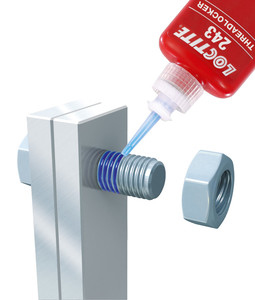

|
Edward Lowton
Editor |


|
| Home> | Production Engineering | >Fasteners, springs and adhesives | >Boosting the reliability of threaded fasteners |
Boosting the reliability of threaded fasteners
22 March 2022
From light duty equipment to heavy machinery, threaded fasteners set and hold tolerances on a wide range of assemblies. But fastener loosening is one of the major causes of industrial equipment failure, writes Bob Orme

IN MANY cases, fasteners that self-loosen contribute to wear and fatigue resulting in poor operating tolerances, misalignment and catastrophic failure. Various types of differential stress – vibration, shock, thermal expansion and contraction and micro-movement – reduce clamping force on the assembly and ultimately cause machine failure.
Pro-active maintenance of threaded fasteners counteracts self-loosening and comes in two basic categories: mechanical locking devices and chemical machinery adhesives or a combination of both.
Threadlocking options
Mechanical devices such as spring washers, wire retainers and locking bolts can be costly and cannot reliably prevent self-loosening caused by side-sliding motion. They also do not seal or prevent corrosion within the fastened assembly and must be sized appropriately for the specific fastener.
Threadlocking adhesives have become one of the most reliable and inexpensive ways to ensure that an assembly will remain locked and leak-proof for its entire service life. What’s more, as the joint is totally sealed it will not corrode together so the parts will be removable years later.
Applied to fastener threads, anaerobic adhesives fill the voids of threads and cure to a hard thermoset plastic. They lock the threaded parts together so mating parts ultimately act as one conjoined component that resists failure.
Most assemblies held together by threaded fasteners will be dismantled for repair, maintenance or adjustment. For this purpose, threadlockers are available in low strength formulations for easy removal; medium strength grades, removable with common hand tools and high strength for very demanding assemblies with minimal service requirements.
Even these highest strength threadlockers, however, can be removed with standard hand tools following direct exposure to temperatures of 230°C to 260°C.
A range of threadlocking adhesive viscosities is available, although in practice, standard products are used for the majority of applications. High viscosity grades are available for locking lose threads and penetrating grades easily wick into pre-assembled fasteners and then lock them in position.
The strength class of the threadlocker is selected based on the thread length engaged, thread size, the strength class of the bolt and the required easiness of disassembly. For a low strength threadlocker, the break-loose torque is lower than the tightening-torque. A medium strength threadlocker has a break-loose torque similar or slightly higher than the tightening-torque. And a high strength threadlocker has a much higher break-loose torque than the tightening-torque.
Best practice
Threadlocking adhesives should only be applied to the thread engagement area as only adhesive between the threads will cure. A good tip is to apply the threadlocker to the bolt thread at a distance of 1 x nut height from the part when locking nuts in place, or to the leading threads of the bolts if assembling into a tapped hole.
For blind hole assemblies such as studs, threadlockers should be applied to the bolt and to the threads within the blind hole. If adhesive is applied only to the bolt, air pressure may force the liquid to escape as the bolt is torqued down and may result in an incomplete cure and possible assembly failure.
The operating conditions of the end-use environment dictate the threadlocking formulation selected. The newest threadlocking technologies offer many advantages over previous generations to include surface-insensitive, high temperature and chemically resistant products as well as formulations that withstand extreme vibration. Recent advances have resulted in increased operating temperatures and the ability to cure on the latest corrosion protection coatings.
Bob Orme is senior applications engineer at Henkel
- Wider scope of application for gasketing adhesive
- For tough tasks
- Wraps, seals & insulate
- Keeping the press rolling
- New structural bonders create limitless opportunities in maintenance and repair
- Clear when cured
- Adhesives range
- Ways to form a special bond
- Product selector guide
- Works at low temperatures


















